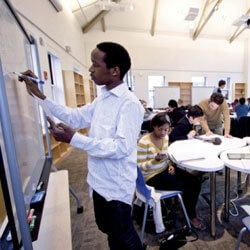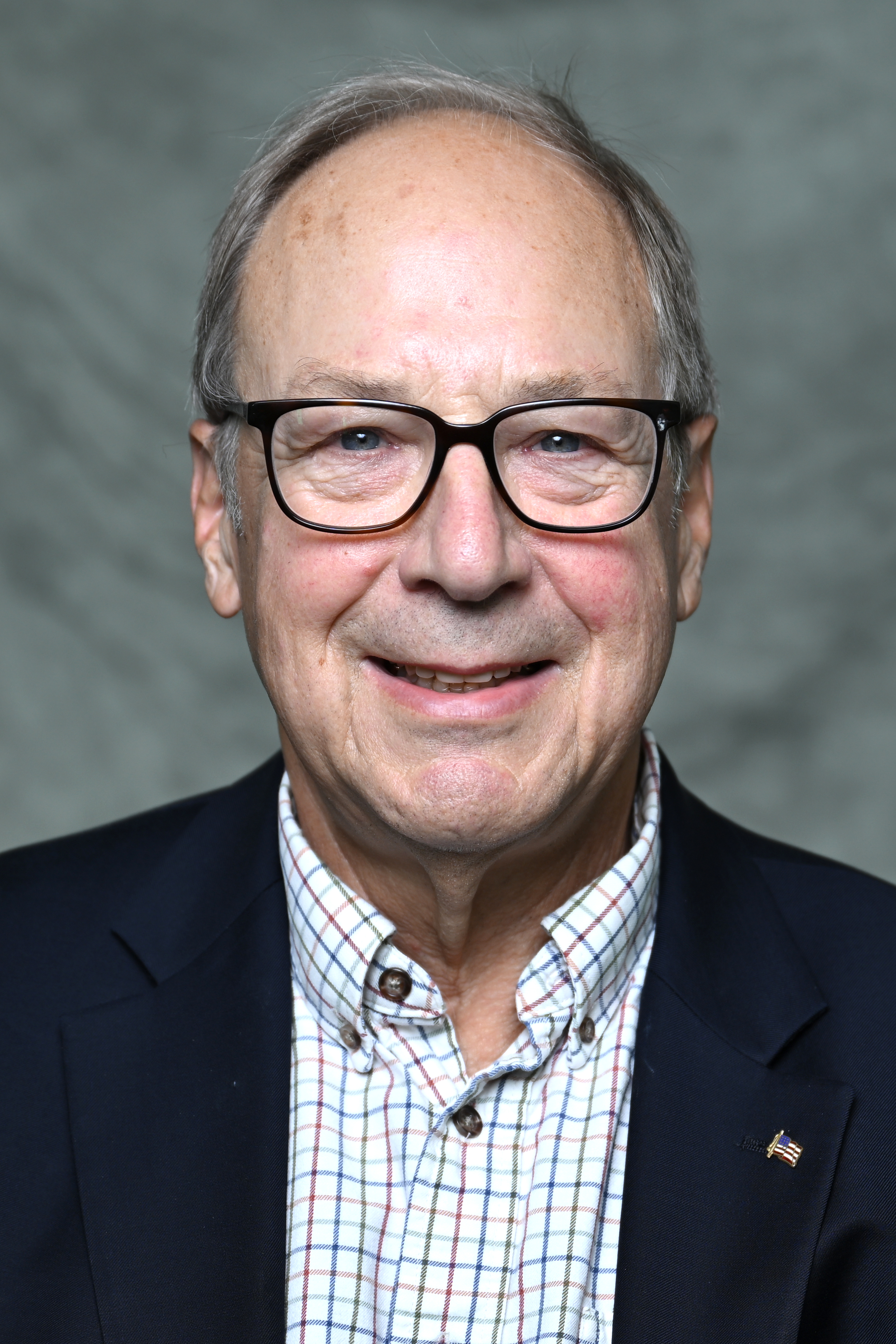News
The classroom of CS 20, in Spring 2012. (Photo by Eliza Grinnell, SEAS Communications.)
(Photos by Eliza Grinnell, SEAS Communications.)
The following is an excerpt from an article by Harry Lewis, Gordon McKay Professor of Computer Science, which appeared in Harvard Magazine on August 17, 2012. Prof. Lewis describes the motivations, the challenges, and the successes of developing the course CS 20 around an innovative and unusual style of teaching.
Computer science is booming at Harvard (and across the country). The number of concentrators has nearly tripled in five years. For decades, most of our students have been converts; barely a third of recent CS graduates intended to study the field when they applied to college. But sometime in 2010, we realized that this boom was different from those of earlier years, when many of our students came to computer science from mathematics, physics, and engineering. Today many seem to be coming from the life sciences, social sciences, and humanities. Never having studied formal mathematics,these students were struggling in our mathematically demanding courses.Their calculus and linear algebra courses did not teach them the math that is used to reason about computer programs: logic, proofs, probability, and counting (figuring out how many poker hands have two pairs, for example). Without these tools they could become good computer programmers, but they couldn’t become computer scientists at all. It was time to create a new course to fill in the background.
I’ve developed big courses like CS 50, our introduction to the field.Courses for specialists, like CS 121 (“Introduction to the Theory of Computation”) and CS 124 (“Data Structures and Algorithms”), the theory courses in the CS concentration. A lecture course mixing math and public policy—my “Bits” course, part of the Core and General Education curricula. Even a freshman seminar for 12, outside my professional expertise: on amateur athletics—really a social history of sports in America, heavily laced with Harvardiana.
So I figured I knew how to create courses. They always come out well—at least by the standard that I can’t possibly do a worse job than the previous instructor!
This time was different. Figuring out the right topics was the easy part. I polled faculty about their upper-level courses and asked them what math they wished their students knew. I looked at the websites of courses at competing institutions, and called some former students who teach those courses to get the real story. (College courses are no more likely to work as advertised than anything else described in a catalog.)Thus was born CS 20, “Discrete Mathematics for Computer Science.”
But once I knew what I needed to teach, I started worrying.
Every good course I have ever taught (or taken, for that matter) had a narrative. “It’s good for you” is not a winning premise for a course.
Every good course I have ever taught (or taken, for that matter) had a narrative. CS 121 is the story of computability, a century-long intellectual history as well as a beautiful suite of mathematical results. “Bits” is the drama of information freedom, the liberation of ideas from the physical media used to store and convey them (see “Study Card”). CS 20, on the other hand, risked being more like therapy—so many treatments of this followed by so many doses of that, all nauseating.“It’s good for you” is not a winning premise for a course.
And what if students did not show up for class? I had no desire to develop another set of finely crafted slides to be delivered to another near-empty lecture hall.
I’ll accept the blame for the declining attendance. My classes are generally video-recorded for an Extension School audience. I believe that if the videos exist, then all my students should have them—and they should have my handouts too. In fact, I think I should share as much of these materials with the world as Harvard’s business interests permit. I could think of ways to force students to show up (not posting my slide decks, or administering unannounced quizzes, for example). But those would be tricks, devices to evade the truth: the digital explosion has changed higher education. In the digital world, there is no longer any reason to use class time to transfer the notes of the instructor to the notes of the student (without passing through the brain of either, as Mark Twain quipped). Instead, I should use the classroom differently.
I decided to change the bargain with my students. Attendance would be mandatory. Homework would be daily. There would be a reading assignment for every class. But when they got to class, they would talk to each other instead of listening to me.
So I decided to change the bargain with my students. Attendance would be mandatory. Homework would be daily. There would be a reading assignment for every class. But when they got to class, they would talk to each other instead of listening to me. In class, I would become a coach helping students practice rather than an oracle spouting truths. We would “flip the classroom,” as they say: students would prepare for class in their rooms, and would spend their classroom time doing what we usually call “homework”—solving problems.
And they would solve problems collaboratively, sitting around tables in small groups. Students would learn to learn from each other, and the professor would stop acting as though his job was to train people to sit alone and think until they came up with answers. A principal objective of the course would be not just to teach the material but to persuade these budding computer scientists that they could learn it. It had to be a drawing-in course, a confidence-building course, not a weeding-out course.
To read the entire article in Harvard Magazine, click here
Perspectives
Paul Handorff '14, Course Assistant:
"When you're doing most of the learning, working on the problems, that's when the course staff are there to support you. For someone who doesn't have a strong math background, who's really enthusiastic about getting into computer science, it would quite possibly be disastrous to just throw them out there and [make them] do all the learning by themselves. We're here to support them while they're doing the hard work. . .
"You need to be willing to get your hands dirty and try different things. Working together in a risk-free environment is a good way to do that."
Abiola Laniyonu '13, Course Assistant:
"It's rather unusual. I think students are learning more.
"This class is designed to give students the tools that they need to solve math-based problems in computer science, and really the only way to make certain that students have those tools is to make them use them. You can be in a lecture on how to use a saw, but that doesn't teach you how to use a saw.
"Some people get things really quickly; others need a little more help and guidance until they get there. . . So [the CA's job involves] balancing the dynamic and making sure that one person isn't dominating the discussion. The point is that all four people should learn from each other. Everyone has to explain the question, and you're not allowed to move on to the next question until everyone can explain the problem that they're working on. In basically any sort of work that you're doing in a team, your teammates aren't mind readers. The only way they can know what you're thinking is for you to articulate that to them. . . I've tried to encourage them, in terms of thinking out loud, that even if it's not polished yet, they should still articulate their thought process so that everyone can understand--well, here are a couple of approaches; let's see what might be the best approach."
Michael Gelbart, Head Teaching Fellow
"I didn't love lectures as an undergrad; in fact I kind of fell asleep most of the time, so I thought it was a good idea. People have been talking about this idea a lot these days--flipping the classroom--so I thought it would be cool to see it in action.
"This is supposed to feel like a language class, with little bits of work to do every day instead of a huge chunk at any point in time.
"There are still people that are shy, and they're mostly the people who were shy originally, but that's up to us, the TFs--to try to be encouraging and nice and get them to talk more. Sometimes I sit down at the table for a few minutes; all these little cues seem to make a difference. I'll just start chatting with them. Officially we're supposed to pick the person that looks the most shy and confused and tell them to go write the solution on the board to make sure that they understand. Sometimes they resent that a little bit, so I don't always do that, but I will sometimes single someone out and ask them to explain it to me. The social engineering is a bit tricky. Sometimes it works and sometimes it doesn't."
Topics: Computer Science, Academics
Cutting-edge science delivered direct to your inbox.
Join the Harvard SEAS mailing list.
Scientist Profiles
Harry R. Lewis
Gordon McKay Professor of Computer Science, Emeritus




